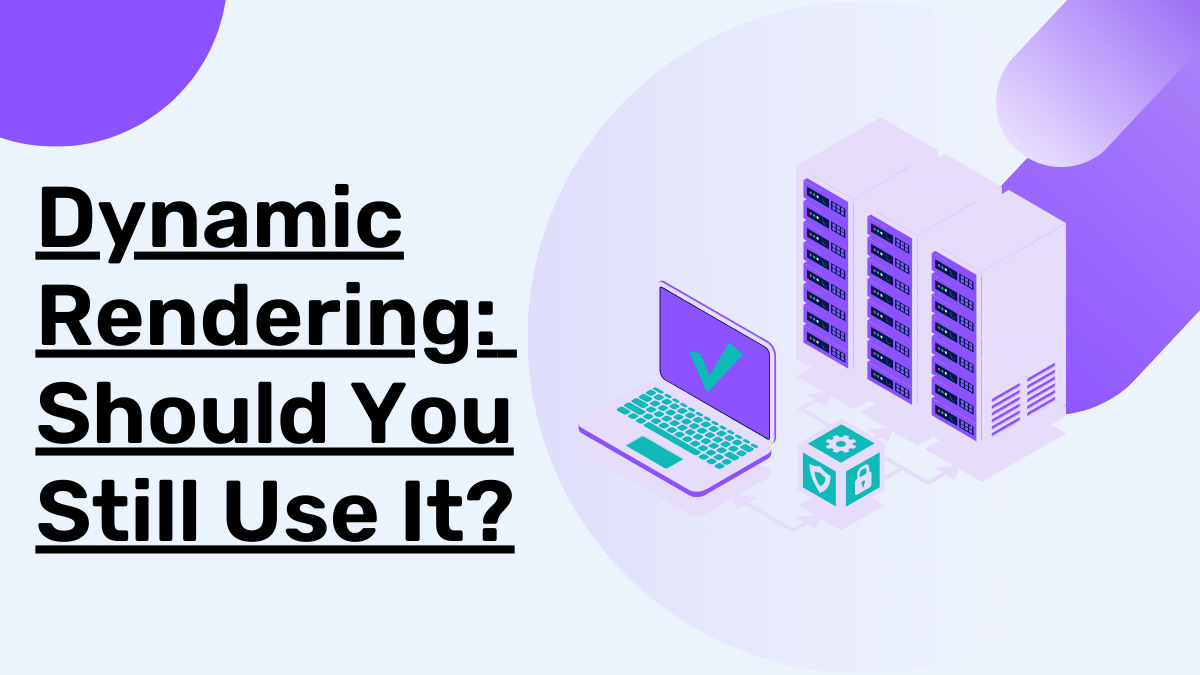SEO
Dynamic Rendering: Should You Still Use It?
Introduction
Dynamic rendering has been a popular technique for optimizing websites and ensuring a smooth user experience. However, with advancements in technology and changes in search engine algorithms, it is essential to reassess the effectiveness of dynamic rendering. In this article, we will explore the concept of dynamic rendering, its benefits and limitations, and whether it is still a viable strategy for website optimization.
What is Dynamic Rendering?
Dynamic rendering is a process that allows websites to serve different versions of their content based on the user agent accessing the site. It involves generating HTML content on the server-side or client-side depending on the device or browser requesting the page. By dynamically adapting the content, websites can optimize the user experience and improve performance.
The Benefits of Dynamic Rendering
Dynamic rendering offers several advantages for website optimization. Let’s take a closer look at some of the key benefits:
1. Improved Performance
Dynamic rendering can significantly enhance the performance of websites by reducing load times. By tailoring the content to the specific device or browser, unnecessary scripts, stylesheets, or heavy media files can be excluded, resulting in faster page load times and a better user experience.
2. Enhanced SEO
Search engine optimization (SEO) is a critical aspect of online visibility, and dynamic rendering can positively impact a website’s search rankings. By providing search engines with pre-rendered HTML content, websites can ensure that search engine bots can efficiently crawl and index their pages, leading to improved visibility and organic traffic.
3. Mobile Optimization
In an increasingly mobile-driven world, optimizing websites for mobile devices is crucial. Dynamic rendering enables websites to serve lightweight, mobile-friendly versions to mobile users, ensuring a seamless browsing experience on smartphones and tablets.
4. Flexibility in Content Delivery
Dynamic rendering allows websites to adapt their content delivery based on specific user needs. For instance, an e-commerce site can render product listings differently for search engines to enhance discoverability, while presenting a visually appealing interface to human visitors. This flexibility empowers website owners to cater to various audiences without compromising performance or user experience.
The Limitations of Dynamic Rendering
While dynamic rendering offers numerous benefits, it also has its limitations. Let’s explore some of the challenges associated with this technique:
1. Increased Complexity
Implementing dynamic rendering can be a complex process, especially for websites with large amounts of dynamic content. It requires careful configuration and coordination between server-side and client-side rendering, which may require additional development resources and expertise.
2. Maintenance Overhead
Dynamic rendering often involves maintaining multiple versions of the same content, tailored for different user agents. This can introduce additional maintenance overhead, as any updates or changes to the website’s structure or content need to be applied to each rendering variant.
3. Potential Content Inconsistencies
As dynamic rendering serves different versions of the content, there is a risk of inconsistencies between the server-side and client-side rendering. It is crucial to ensure that both versions accurately reflect the same information to avoid confusing or misleading users and search engines.
Frequently Asked Questions
FAQ 1: What are the main differences between server-side and client-side dynamic rendering?
Server-side dynamic rendering generates HTML content on the server and delivers pre-rendered pages to user agents. Client-side dynamic rendering, on the other hand, relies on JavaScript to generate HTML content dynamically within the user’s browser.
FAQ 2: Is dynamic rendering suitable for all types of websites?
Dynamic rendering is most beneficial for websites with a significant amount of dynamic content that can benefit from optimization based on user agents. However, for static websites with minimal variations in content, the advantages of dynamic rendering may not be as prominent.
FAQ 3: How does dynamic rendering affect search engine crawling and indexing?
Dynamic rendering can improve search engine crawling and indexing by providing pre-rendered HTML content that is easily accessible to search engine bots. This can result in better visibility and higher search rankings.
FAQ 4: Are there alternative optimization techniques to dynamic rendering?
Yes, there are alternative techniques for optimizing websites, such as responsive web design and progressive web apps. These approaches focus on creating websites that can adapt to different devices and user agents without the need for dynamic rendering.
FAQ 5: Can dynamic rendering negatively impact website performance?
While dynamic rendering can enhance performance in most cases, improper implementation or configuration can lead to slower page load times. It is essential to optimize the rendering process and ensure efficient content delivery to maintain optimal performance.
FAQ 6: Should I consider dynamic rendering for my website?
The decision to implement dynamic rendering depends on various factors, including the complexity of your website, the amount of dynamic content, and your target audience. Consulting with a web development expert can help you determine whether dynamic rendering is suitable for your specific needs.
Conclusion
Dynamic rendering has been a valuable technique for website optimization, offering improved performance, enhanced SEO, and flexible content delivery. However, it is essential to carefully consider the complexity, maintenance overhead, and potential content inconsistencies associated with dynamic rendering. By weighing the benefits against the limitations and exploring alternative optimization techniques, website owners can make informed decisions regarding the use of dynamic rendering.
Remember, in the ever-evolving landscape of web development and SEO, staying up-to-date with the latest practices and trends is vital for maintaining a competitive edge.

